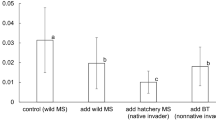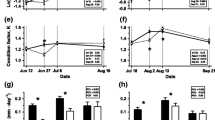Abstract
Juvenile bull trout Salvelinus confluentus from two geographically and ecologically distinct populations were compared with regard to their ability to compete with non-native brook trout Salvelinus fontinalis in an artificial stream, and with respect to their rates of oxygen consumption. Bull trout collected from a migratory population foraged more successfully against brook trout competitors than those from a resident population, capturing more of a limited amount of food items presented. The migratory population was also more aggressive (measured by the number of nips, chases and lateral threat displays) against brook trout competitors than the resident population. Bull trout from the migratory population had a higher oxygen consumption rate (203 mg O2 kg · hr-1) in the field than similar sized fish from the resident population (183 mg O2 kg · hr-1). These results suggest native bull trout have population-level variation in competitive ability against a non-native species and such competitive ability is positively associated with metabolism and migratory life history.



Similar content being viewed by others
References
Biro PA, Stamps JA (2008) Are animal personality traits linked to life-history productivity? Trends in Ecol Evol 23:361–368
Biro PA, Stamps JA (2010) Do consistent individual differences in metabolic rate promote consistent individual differences in behavior? Trends in Ecol Evol 25:653–659
Biro PA, Abrahams MV, Post JR, Parkinson EA (2004) Predators select against high growth rates and risk-taking behaviour in domestic trout populations. Proc R Soc London, Ser B 271:2233–2237
Cutts CJ, Brembs B, Metcalfe NB, Taylor AC (1999) Prior residence, territory quality and life-history strategies in juvenile Atlantic salmon (Salmo salar L.). J Fish Biol 55:784–794
Cutts CJ, Adams CE, Campbell A (2001) Stability of physiological and behavioural determinants of performance in Arctic char (Salvelinus alpinus). Can J Fish Aquat Sci 58:961–968
De Staso J, Rahel FJ (1994) Influence of water temperature on interactions between juvenile Colorado River cutthroat trout and brook trout in a laboratory stream. Trans Am Fish Soc 123:289–297
Dunbrack RL, Clarke L, Bassler C (1996) Population level differences in aggressiveness and their relationship to food density in a stream salmonid (Salvelinus fontinalis). J Fish Biol 48:615–622
Dunham JB, Adams SB, Schroeter RE, Novinger DC (2002) Alien invasions in aquatic ecosystems: toward an understanding of brook trout invasions and potential impacts on inland cutthroat trout in western North America. Rev Fish Biol Fish 12:373–391
Dunham J, Baxter C, Fausch K, Fredenberg W, Kitano S, Koizumi I, Morita K, Nakamura T, Rieman B, Savvaitova K, Stanford J, Taylor E, Yamamoto S (2008) Evolution, ecology, and conservation of Dolly Varden, white-spotted char, and bull trout. Fisheries 33:537–550
Forseth T, Naesje TF, Jonsson B, Harsaker K (1999) Juvenile migration in brown trout: a consequence of energetic state. J Anim Ecol 68:783–793
Gowan C, Young MK, Fausch KD, Riley SC (1994) Restricted movement in stream salmonids—a paradigm lost. Can J Fish Aquat Sci 51:2626–2637
Gunckel SL, Hemmingsen AR, Li JL (2002) Effect of bull trout and brook trout interactions on foraging habitat, feeding behavior, and growth. Trans Am Fish Soc 131:1119–1130
Guy CS, McMahon TE, Fredenberg W, Smith CJ, Garfield DW, Cox BS (2011) Diet overlap of top-level predators in recent sympatry: bull trout and nonnative lake trout. J Fish Wildl Manag 2:183–189
Homel K, Budy P, Pfrender ME, Whitesel TA, Mock K (2008) Evaluating genetic structure among resident and migratory forms of bull trout (Salvelinus confluentus) in Northeast Oregon. Ecol Freshw Fish 17:465–474
Hutchison MJ, Iwata M (1997) A comparative analysis of aggression in migratory and non-migratory salmonids. Environ Biol Fish 50:209–215
Lahti K, Laurila A, Enberg K, Piironen J (2001) Variation in aggressive behaviour and growth rate between populations and migratory forms in the brown trout, Salmo trutta. Anim Behav 62:935–944
Lahti K, Huuskonen H, Laurila A, Piironen J (2002) Metabolic rate and aggressiveness between brown trout populations. Funct Ecol 16:167–174
Leisnham PT, Juliano SA (2010) Interpopulation differences in competitive effect and response of the mosquito Aedes aegypti and resistance to invasion by a superior competitor. Oecologia 164:221–230
Macneale KH, Sanderson BL, Courbois J-Y, Kiffney PM (2010) Effects of non-native brook trout (Salvelinus fontinalis) on threatened juvenile Chinook salmon (Oncorhynchus tshawytscha) in an Idaho stream. Ecol of Freshw Fish 19:139–150
McMahon TE, Zale AV, Barrows FT, Selong JH, Danehy RJ (2007) Temperature and competition between bull trout and brook trout: a test of the elevation refuge hypothesis. Trans Am Fish Soc 136:1313–1326
McPhail JD, Baxter JS (1996) A review of bull trout (Salvelinus confluentus) life-history and habitat use in relation to compensation and improvement opportunities. Fisheries management report 104. pp 31, University of British Columbia, Vancouver, BC
Metcalfe NB (1998) The interaction between behavior and physiology in determining life history patterns in Atlantic salmon (Salmo salar). Can J Fish Aquat Sci 55:93–103
Metcalfe NB, Taylor AC, Thorpe JE (1995) Metabolic rate, social status and life history strategies in Atlantic salmon. Anim Behav 49:431–436
Morinville GR, Rasmussen JB (2003) Early juvenile bioenergetic differences between anadromous and resident brook trout (Salvelinus fontinalis). Can J Fish Aquat Sci 60:401–410
Morinville GR, Rasmussen JB (2006) Does life-history variability in salmonids affect habitat use by juveniles? A comparison among streams open and closed to anadromy. J Anim Ecol 75:693–704
Nakano S, Kitano S, Nakai K, Fausch KD (1998) Competitive interactions for foraging microhabitat among introduced brook charr, Salvelinus fontinalis, and native bull charr, S. confluentus, and westslope cutthroat trout, Oncorhynchus clarki lewisi, in a Montana stream. Environ Biol Fish 52:345–355
Nelson ML, McMahon TE, Thurow RF (2002) Decline of the migratory form in bull charr, Salvelinus confluentus, and implications for conservation. Environ Biol Fish 64:321–332
Northcote TG (1992) Migration and residency in stream salmonids. Some ecological considerations and evolutionary consequences. Nord J Freshw Res 67:5–17
Paul AJ, Post JR (2001) Spatial distribution of native and nonnative salmonids in streams of the eastern slopes of the Canadian Rocky Mountains. Trans Am Fish Soc 130:417–430
Peterson DP, Fausch KD, White GC (2004) Population ecology of an invasion: effects of brook trout on native cutthroat trout. Ecol Appl 14:754–772
Rasmussen JB, Robinson MD, Hontela A, Heath DD (2012) Metabolic traits of westslope cutthroat trout, introduced rainbow trout and their hybrids in an ecotonal hybrid zone along an elevation gradient. Biol J Linn Soc 105:56–72
Reale D, Garant D, Humphries MM, Bergeron P, Careau V, Montiglio PO (2010) Personality and the emergence of the pace-of-life syndrome concept at the population level. Phil Trans R Soc B Biol Sci 365:4051–4063
Rich CF, McMahon TE, Rieman BE, Thompson WL (2003) Local-habitat, watershed, and biotic features associated with bull trout occurrence in Montana streams. Trans Am Fish Soc 132:1053–1064
Ridgway MS (2008) A roadmap for coasters: landscapes, life histories, and the conservation of brook trout. Trans Am Fish Soc 137:1179–1191
Rieman BE, Peterson JT, Myers DL (2006) Have brook trout (Salvelinus fontinalis) displaced bull trout (Salvelinus confluentus) along longitudinal gradients in central Idaho streams? Can J Fish Aquat Sci 63:63–78
Rodtka MC (2009) Status of the Bull Trout (Salvelinus confluentus) in Alberta: Update 2009. pp. 48, Alberta Sustainable Resources Development, Alberta Conservation Association, Edmonton, AB
Rodtka MC, Volpe JP (2007) Effects of water temperature on interspecific competition between juvenile bull trout and brook trout in an artificial stream. Trans Am Fish Soc 136:1714–1727
Rossong MA, Quijon PA, Snelgrove PVR, Barrett TJ, McKenzie CH, Locke A (2012) Regional differences in foraging behaviour of invasive green crab (Carcinus maenas) populations in Atlantic Canada. Biol Invasions 14:659–669
Warnock WG (2012) Examining brook trout invasion into bull trout streams of the Canadian Rockies, Ph.D. Thesis. University of Lethbridge, Lethbridge, AB. 184 pp
Warnock WG, Rasmussen JB (2013a) Abiotic and biotic factors associated with brook trout invasiveness into bull trout streams of the Canadian Rockies. Can J Fish Aquat Sci 70(6):905–914
Warnock WG, Rasmussen JB (2013b). Assessing the effects of fish density, habitat complexity and current velocity on interference competition between bull trout and brook trout in an artificial stream. Can J Zool. doi:10.1139/cjz-2013-0044
Warnock WG, Rasmussen JB, Taylor EB (2010) Genetic clustering methods reveal bull trout (Salvelinus confluentus) fine-scale population structure as a spatially nested hierarchy. Conserv Genet 11:1421–1433
Warnock WG, Blackburn JK, Rasmussen JB (2011) Estimating proportional contributions of migratory bull trout from hierarchical populations to mixed-stock recreational fisheries using genetic and trapping data. Trans Am Fish Soc 140:345–355
Warren CE, Liss WJ (1980) Adaptation to aquatic envrionments. In: Lackey RT, Nielsen L (eds) Fisheries managment. Blackwell Scientific Publications, Oxford
Acknowledgments
We thank R. Gresswell, D. Wig, M. Coombs, M. Rodtka, R. Laird, A. Hurly, T. Burg, C. Goater, C. Goodman, C. Adrian, K. Kuchapski, R. Annett, R. Royer, L. Miller, A. Hontela, M. Lalumiere for their discussion, technical assistance and comments. We also thank the anonymous reviewers that provided comments on this manuscript. Operational costs of this research were supported by an Alberta Conservation Association Grant Eligible Conservation Fund, Trout Unlimited Canada’s Coldwater Conservation Fund, and the Natural Sciences and Engineering Research Council of Canada’s (NSERC) Discovery Grant to J.B.R. Graduate fellowships were provided to W.G.W. by an NSERC Industrial Postgraduate Scholarship. Fish were cared for in accordance with the guidelines of the Canadian Council on Animal Care and the study was reviewed and approved by the University of Lethbridge Animal Welfare Committee.
Author information
Authors and Affiliations
Corresponding author
Electronic supplementary material
Below is the link to the electronic supplementary material.
Supplementary Information 1
(XLS 24 kb)
Rights and permissions
About this article
Cite this article
Warnock, W.G., Rasmussen, J.B. Comparing competitive ability and associated metabolic traits between a resident and migratory population of bull trout against a non-native species. Environ Biol Fish 97, 415–423 (2014). https://doi.org/10.1007/s10641-013-0161-3
Received:
Accepted:
Published:
Issue Date:
DOI: https://doi.org/10.1007/s10641-013-0161-3




